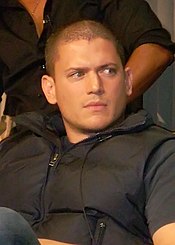Resident Evil: Afterlife
It stars Milla Jovovich, Ali Larter, Kim Coates, Shawn Roberts, Spencer Locke, Boris Kodjoe, and Wentworth Miller.
The film follows Alice searching for and rescuing the remaining survivors in Los Angeles after the T-virus outbreak, and teaming up against Albert Wesker, the head of the Umbrella Corporation.
Extinction was released in 2007 and was a box office success, prompting Afterlife to begin development in June 2008, with the script being written by Anderson that December.
Elements from the video game Resident Evil 5 (2009) were incorporated into the film including the mind control devices and Chris' confrontation with Wesker.
Alice and her clones lead the assault on Umbrella HQ in Tokyo[a], slaying the entire branch except for Albert Wesker, who escapes in a tiltrotor plane and detonates a bomb that leaves a massive sinkhole.
Wesker is revealed to have used the T-virus to gain his own superhuman abilities and prepares to kill Alice before the plane crashes into the mountains.
Six months later, Alice travels to Alaska in an airplane, tracking broadcasts from a safe haven called Arcadia; she only finds abandoned planes and is attacked by a feral Claire Redfield.
They meet Luther West, who leads the surviving band from the prison, Wendell, Crystal Waters, Bennett, Kim Yong, and Angel Ortiz.
With their help, Alice lands on the prison's roof and learns Arcadia is not a fixed place, but a cargo tanker traveling along the coast.
Luther takes Alice to the last inmate, Chris, who insists he is falsely imprisoned and will reveal an escape route in exchange for freedom.
The T-virus revived him, but it battles Wesker for control, something he believes fresh human DNA can pacify; the Umbrella staff fled when he began eating test subjects.
During a mid-credits scene in one of the aircraft, Jill Valentine, who went missing after the destruction of Raccoon City,[c] is dictating the attack wearing the same mind control device used on Claire.
In May 2005, producers mentioned the possibility of following Extinction with a sequel entitled Afterlife, to be shot and set in Tokyo, Japan and Alaska.
"[10] Producer Jeremy Bolt also stated that while there was no intention of making a fourth film, that the third had been particularly well done and that Paul Anderson was talking with Sony about the possibility.
[14] In September 2006, reports indicated that casting for the fourth film had begun, with Jensen Ackles being considered for the role of Leon S.
Having never played the Resident Evil video games,[8] Miller began preparing for the role by searching the internet for images of Chris Redfield.
Much to his surprise, he noticed how muscular the character was; with only three weeks to prep before shooting, he knew it was impossible to increase his muscle mass to that extent.
Anderson was shown footage of James Cameron's Avatar, which sold him on the idea to shoot Resident Evil: Afterlife in digital 3D.
[31] For slow motion scenes with bullets and drops of water, twin Phantom high-speed cameras were used which filmed 200 frames per second.
[37] Toronto police received hundreds of calls from concerned neighbors after a scene involving a burning plane crashed.
"[42] A burned cityscape with ash and smoke in the sky was created to depict a postapocalyptic Los Angeles, in which most of the film is set.
Bolt described this approach as: "In a world that has gone to hell in a handbasket, there's no control and no fire service, so clearly, what's going to happen to LA is it's going to get burned.
[45][46] Other creatures borrowed from the fifth video game are the "Majini", who are more intelligent and have mandibles and tentacles coming out of their mouths, and "The Executioner" (named the Axeman in the film).
[51] On April 3, 2010, Anderson, Jovovich and Larter attended WonderCon for a Resident Evil: Afterlife, panel answering fan questions.
[31] The Resident Evil: Afterlife: Music from the Motion Picture was composed by Tomandandy and released on September 28, 2010, by Milan Records.
[60] On its fourth weekend, Resident Evil: Afterlife moved to eleventh place, with the newly-released Case 39 at number one, while grossing $2.7 million and being dropped from 735 theaters.
The site's consensus states: "As dim-witted and lifeless as its undead antagonists, Resident Evil: Afterlife is a wholly unnecessary addition to the franchise.
[78] Chicago Reader's Andrea Gronvall described the plot as "nearly indiscernible", but did call the film the "sleekest so far, thanks to 3D and star Milla Jovovich's body-hugging catsuit".
[79] Jeannette Catsoulis of The New York Times gave the film a negative review, saying: "Cannibalizing John Carpenter's Thing and much of the sci-fi-horror canon, Afterlife is more moribund than its thronging undead".
[83] A particularly scathing review came from Brian Orndorf of Dark Horizons, who commented: "Perhaps the first 3D motion picture to simulate the experience of watching paint dry, Resident Evil: Afterlife is a dreadful bore that only occasionally comes to life.




